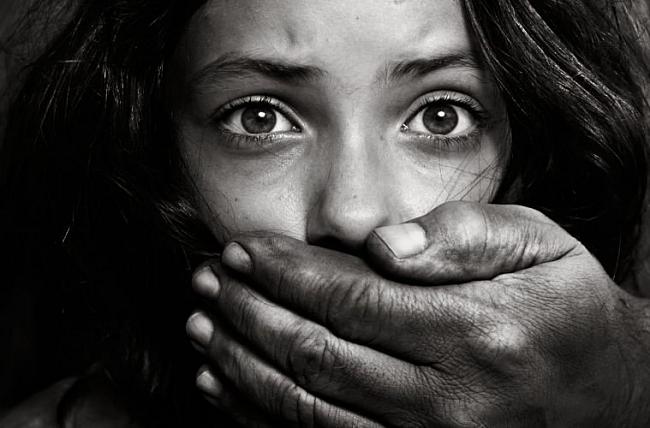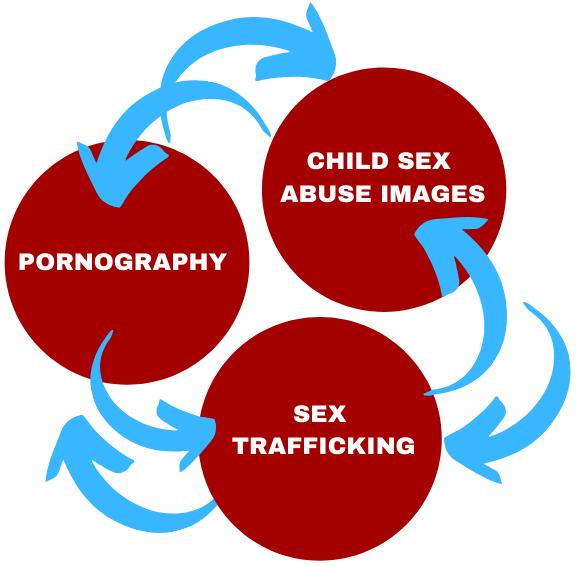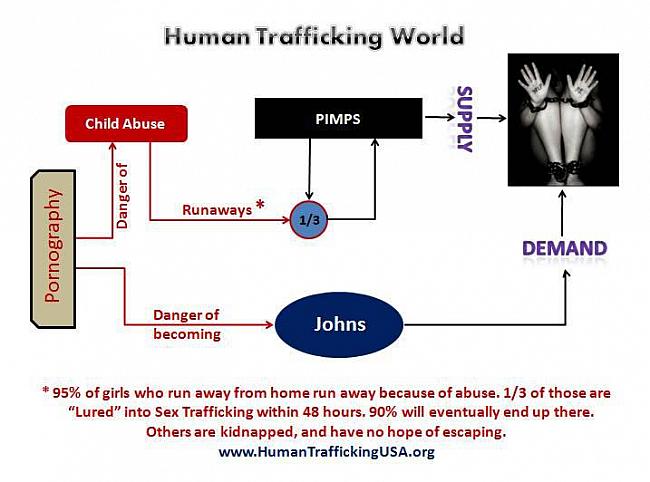Sex Trafficking
Sex trafficking occurs when someone uses force, fraud or coercion to cause a commercial sex act with an adult or causes a minor to commit a commercial sex act.
Traffickers are using the Internet as a way to target unsuspecting and vulnerable youth for their own personal financial gain. Traffickers seen their intended prey nothing more than a dollar sign. Sex trafficking is a form of modern-day slavery that exists throughout the United States and globally. According to the F.B.I., sex trafficking is the 2nd largest criminal industry per illicit revenue generated -- just behind drug trafficking. It is an easy, low risk (lack of training and awareness for frontline professionals leaves many victims undetected), high yield industry (highly profitable due to a huge consumer demand – often fueled by the pornography industry).
 Much like the grooming tactics employed by sexual predators, sex often traffickers lure their target into an online relationship, with the ultimate goal of meeting in person. Traffickers use a deliberate process to identify and recruit their victims. It happens in three main phases: scouting, manipulating and trapping. Victims are often showered with love, romance and promises of a better life. Others are lured in with false promises of a job, or given expensive gifts. The end game of the trafficker (or pimp) however, is to force or manipulate their target into commercial sex.
Much like the grooming tactics employed by sexual predators, sex often traffickers lure their target into an online relationship, with the ultimate goal of meeting in person. Traffickers use a deliberate process to identify and recruit their victims. It happens in three main phases: scouting, manipulating and trapping. Victims are often showered with love, romance and promises of a better life. Others are lured in with false promises of a job, or given expensive gifts. The end game of the trafficker (or pimp) however, is to force or manipulate their target into commercial sex.
Left unchecked, human trafficking will continue to flourish in environments where traffickers can reap substantial monetary gains with relatively low risk of getting caught or losing profits. Despite growing awareness about this crime, it continues to go underreported due to its covert nature, misconceptions about its definition, and a lack of awareness about its indicators.
What is Teen Sex Trafficking?
- Sex trafficking: the recruitment, harboring, transportation, provision, or obtaining of a person for the purpose of a commercial sex act, in which the commercial sex act is induced by force, fraud, or coercion, or in which the person induced to perform such act has not attained 18 years of age. (Note: It is not necessary to demonstrate force, fraud, or coercion in sex trafficking cases involving children under the age of 18.)
What Does a Trafficker "Look Like?"
- A trafficker can be anyone -- a classmate, employer, family friend, acquaintance, a boyfriend/girlfriend, or someone you met online.
- Traffickers often pretend to be someone they are not by setting up fake accounts online to "friend" a teen, and then groom them using a variety of techniques to gain their trust.
Who Do Traffickers Target?
- Teens (both boys and girls) between the ages of 12-19 are victims, but some have been as young as 9.
- Teens from all different socioeconomic and ethnic backgrounds are targets
- Traffickers often seek out children online who appear vulnerable, depressed, seem emotionally isolated from family and friends, have low-esteem or appear to have a lot of unsupervised time.
- Runaway and homeless youth, as well as victims of domestic violence, sexual assault, war or conflict, or social discrimination are frequently targeted by traffickers.
Red Flags of Potential Sex Trafficking in Children:
- Unexplained absences from school
- Changes in usual attire, behavior or relationships
- Suddenly has more expensive material possessions
- Chronically runs away from home
- Fearful, anxious, depressed, submissive, tense, or nervous and paranoid
- Defers to another person to speak for him or her, especially during interactions with school authority figures
- Show signs of physical and/or sexual abuse, physical restraint, confinement or other serious pain or suffering
- Seems to be deprived of food, water, sleep, medical care or other life necessities
- Has new branding/tattoos
- Has a “boyfriend” or “girlfriend” who is noticeably older
- Makes references to sexual situations or terminology that are beyond age-specific norms or engaging in uncharacteristically promiscuous behavior
Pornography and Sex Trafficking – Are they Related?
- Some types of pornography actually are sex trafficking, specifically as the production of pornography often involves the use of force, fraud or coercion to prompt the performance of those shown in the pornography.
- Traffickers often exploit their victims by recording the acts they perform. These videos are often used as training.
- Supply and Demand: The supply is the victim. The distribution is the trafficker or the online material. The demand is the “John”, the purchaser of the sex act.
Related articles:
The Connection Between Sex Trafficking and Pornography (Human Trafficking Search)
The Connections Between Pornography and Sex Trafficking? (Covenant Eyes)
How Can I Protect My Teen?
- Look for at-risk warning signs (staying out later than usual, change in friends, withdrawing from activities, spending time with suspicious individuals, unexplained possessions/access to money)
- Implement the guidelines contained in Enough Is Enough®'s "Rules 'N Tools" to protect Internet-enabled devices.
- To report a tip or get help, contact the National Human Trafficking Hotline at 1-888-373-7888. In the event of an emergency, call 911.
- How to Talk About Human Trafficking with Children and Adolescents (Click here to view information from Baylor University)
- Radlee app for parents uses Artificial Intelligence (AI) to help protect your children from online predators.
Trafficking Resources
Child Sex Trafficking: 10 Facts You Need To Know (infographic courtesy of Tyndale House Publishers)
Click Here to see additional sex trafficking resources.
Porn and Sex Trafficking: 10 Facts from the Experts (Posted on Covenant Eyes)
2018 Federal Human Trafficking Report
Global Research: The Essence of Evil: Sex with Children Has Become Big Business in America


 Much like the grooming tactics employed by sexual predators, sex often traffickers lure their target into an online relationship, with the ultimate goal of meeting in person. Traffickers use a deliberate process to identify and recruit their victims. It happens in three main phases: scouting, manipulating and trapping. Victims are often showered with love, romance and promises of a better life. Others are lured in with false promises of a job, or given expensive gifts. The end game of the trafficker (or pimp) however, is to force or manipulate their target into commercial sex.
Much like the grooming tactics employed by sexual predators, sex often traffickers lure their target into an online relationship, with the ultimate goal of meeting in person. Traffickers use a deliberate process to identify and recruit their victims. It happens in three main phases: scouting, manipulating and trapping. Victims are often showered with love, romance and promises of a better life. Others are lured in with false promises of a job, or given expensive gifts. The end game of the trafficker (or pimp) however, is to force or manipulate their target into commercial sex.